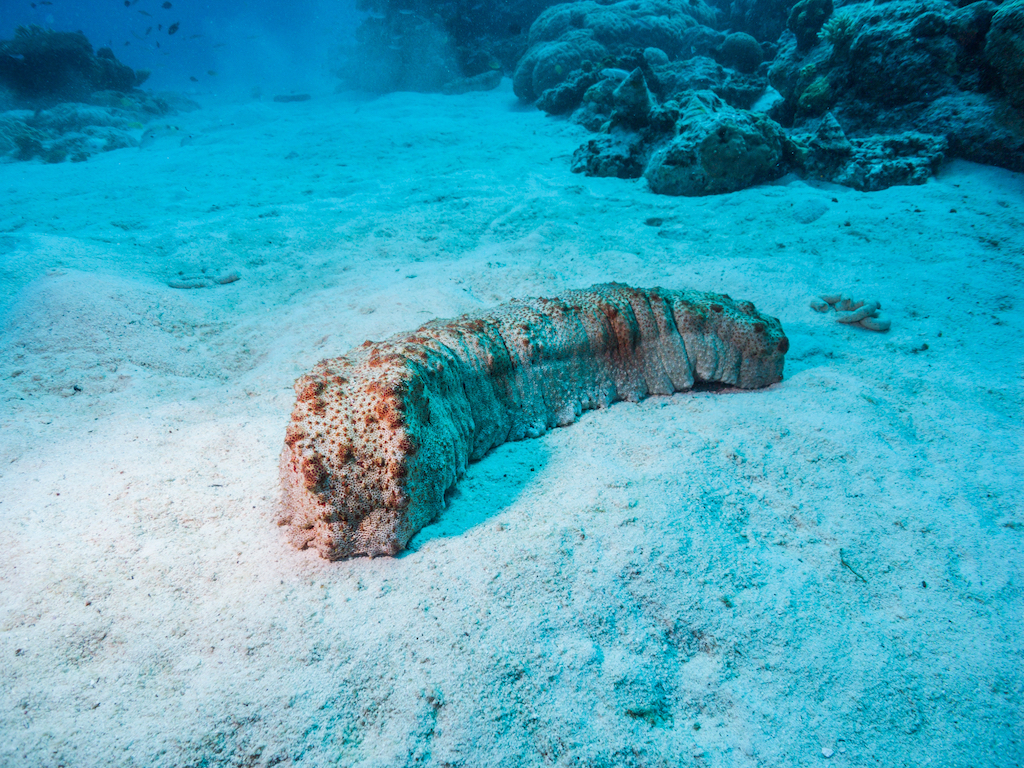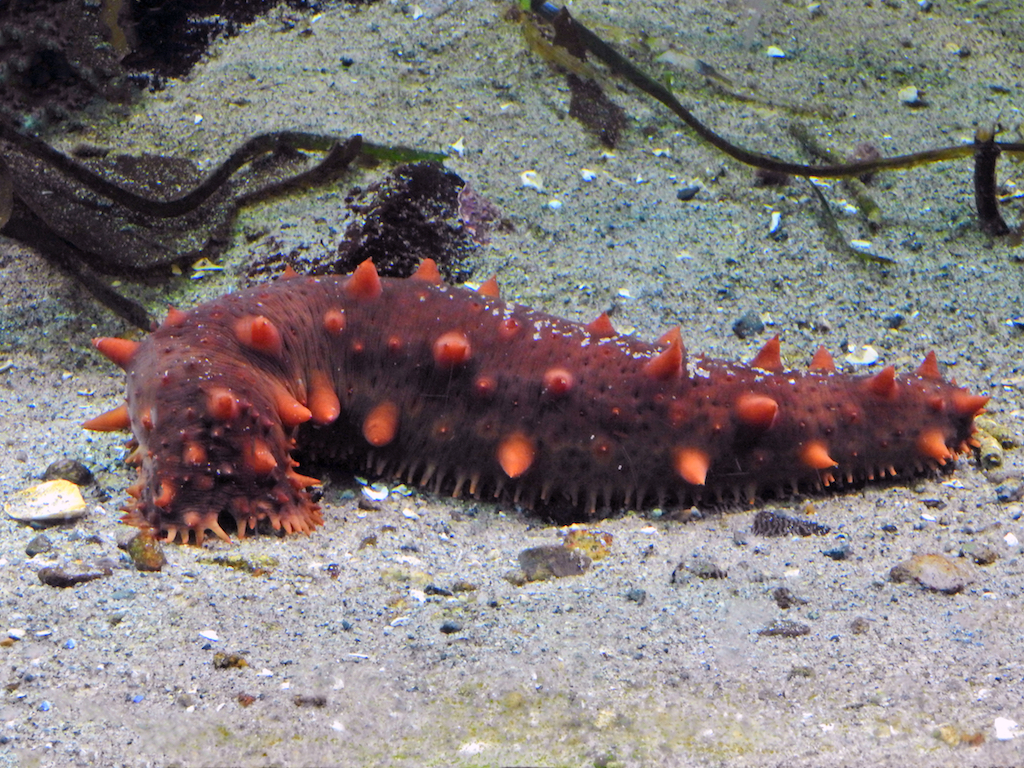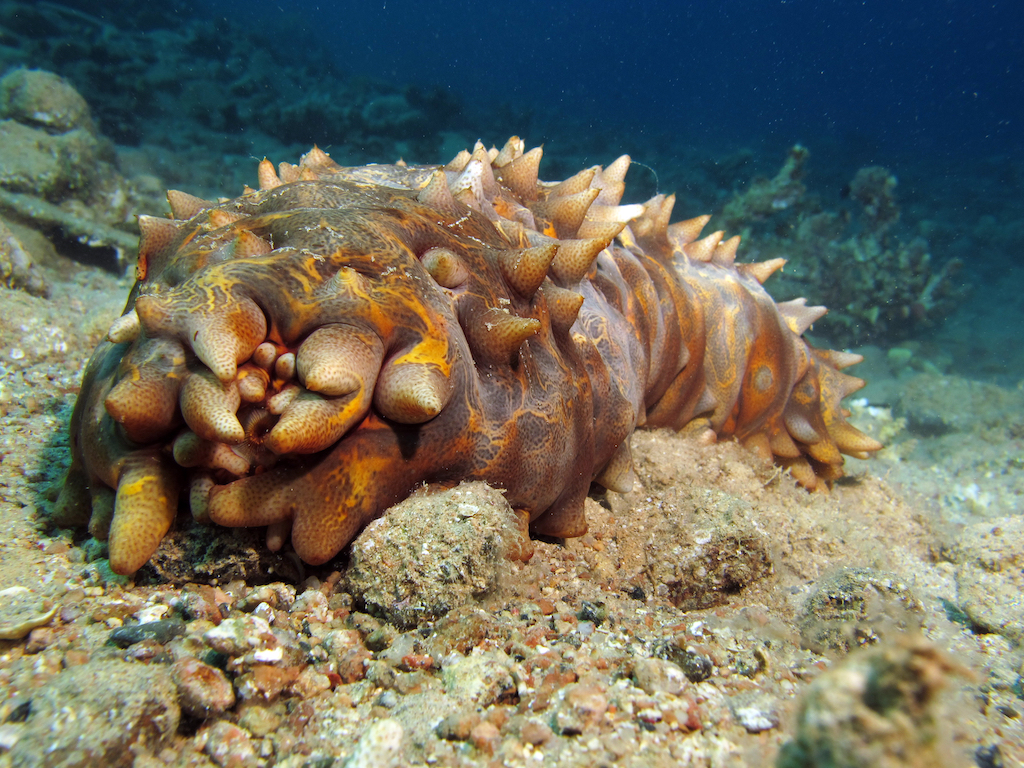What Is a Sea Cucumber?
Reference Article: Facts about sea cucumbers.

Sea cucumbers are marine invertebrates that live on the seafloor. They're named for their unusual oblong shape that resembles a fat cucumber. Although people occasionally eat sea cucumbers, these chubby, worm-like sea creatures aren't related to their namesake fruit (and they wouldn't make a very appetizing salad topping if you were expecting a crunchy, refreshing bite).
There are about 1,250 species of sea cucumber, all of which belong to the taxonomic class Holothuroidea. This class falls under the Echinodermata phylum, which also includes many other well-known marine invertebrates, such as sea stars, sea urchins and sand dollars, according to National Geographic.
Sea cucumbers range in size from about three-quarters of an inch (1.9 centimeters) to more than 6 feet long (1.8 meters) and live throughout the world's oceans, from nearshore shallow waters to the ocean's deepest trenches, according to the National Wildlife Federation. No matter the depth, their main residence is on the ocean floor, often partially buried in sand.
Related: 7 Bizarre Facts About the Ocean
Sea cucumbers, like all other echinoderms, exhibit radial symmetry, according to the University of California, Berkeley's Museum of Paleontology (UCMP). But instead of having five arms arranged in a circle like sea stars or sand dollars, sea cucumbers have five rows of tiny feet that run lengthwise down their bodies, from mouth to anus. Their tube-shaped feet serve mainly to anchor the limbless creatures to the seafloor, according to Woods Hole Oceanographic Institution (WHOI). Sea cucumbers move across the seafloor by changing the water pressure in their feet; they increase the amount of water in their feet to stretch them out and release the water to contract them.
What do sea cucumbers eat?
As the creatures slowly meander about, they use the extra 20 to 30 little tube feet around their mouths to shovel everything in, including sand. They feed primarily on tiny pieces of algae and marine creatures, which get broken down into smaller and smaller pieces, similar to how earthworms break down organic matter in gardens, according to the National Oceanic and Atmospheric Administration (NOAA).The sand that the sea cucumbers ingest passes straight through their system and comes out the other end in the form of a sandy poop log.
Related: Watch This Giant Sea Cucumber Expel a Spiraling Poop Log
Get the world’s most fascinating discoveries delivered straight to your inbox.
Along with the sand, sea cucumbers excrete byproducts that benefit ocean ecosystems, particularly coral reefs. A 2011 study published in the Journal of Geophysical Research found that sea cucumbers' natural digestion process gives their waste products a relatively high (or basic) pH, which means the water surrounding sea cucumber habitats is somewhat protected from ocean acidification. Sea cucumbers also excrete calcium carbonate, which is a primary ingredient in coral formation, and ammonia, which acts as a fertilizer and promotes coral growth.
Anatomy and reproduction
Sea cucumbers have a relatively simple internal anatomy, consisting of three main sections: digestive, respiratory and reproductive, according to the book "Marine Benthic Fauna of Chilean Patagonia" (Nature in Focus, 2010).
Although sea cucumbers don't have bones, many species of the animal have a rudimentary skeleton made of microscopic plates of calcium carbonate that lie loosely scattered underneath the skin, according to UCMP. Some species can align their skeletal plates when threatened so that their bodies become rigid, according to the University of Alaska Southeast.
The digestive tract consists of a long intestine coiled between the mouth and the anus that's approximately two to three times the length of the sea cucumber. Occasionally, if disturbed or stressed, sea cucumbers will expel their entire digestive system, but they can grow a replacement in just a few weeks, according to WHOI.






A sea cucumber's respiratory system is made up of two respiratory trees on either side of the digestive tract, according to the University of Alaska Southeast. Water flows into the body through the base of the two Y-shaped trees at the anus, and oxygen is transferred across a thin membrane into the body cavity.
Most species of sea cucumbers reproduce sexually via external fertilization, according to National Geographic. This means that the males release their sperm into the water and females release their eggs into the water, and hopefully a few egg and sperm run into each other. The animals must release hundreds of thousands of sperm and egg cells to increase the chances of fertilization occurring.
The sea cucumber larvae drift with the currents until they grow large enough to latch onto the ocean floor.
Scientists have identified at least 16 species of sea cucumber that can also reproduce asexually, by splitting in two, according to a 2017 article published in the journal Ecology and Evolution. Each half of the split sea cucumber regenerates the organs it's missing and essentially becomes a clone of the original animal.
People eat lots of sea cucumbers
The International Union for Conservation of Nature and Natural Resources (IUCN) categorizes a few species of sea cucumber (such as the brown sea cucumber, Isostichopus fuscus) as vulnerable or endangered. But most species are considered a species of least concern, or there are not enough data to make an accurate assessment of the species' population.
With the exception of some populations in temperate waters in the Northern Hemisphere, sea cucumbers are heavily fished, according to a 2010 report from the Food and Agriculture Organization of the United Nations (FAO). Most of the animals that are harvested are exported to Asian markets, where sea cucumbers are considered a delicacy.
In some areas, such as Papua New Guinea, overfishing of sea cucumbers has completely decimated the local population, Cool Green Science reported. Much of the sea cucumber trade occurs on the black market, according to the U.S. Department of Justice.
Related: Men Fined $1 Million for Trafficking $17 Million Worth of Squishy Sea Cucumbers
The FAO has released guidelines for the sustainable harvesting of sea cucumbers around the world. These guidelines have become laws in some countries, but many places don't have the resources to enforce the regulations. As scientists continue to learn more about sea cucumbers, the FAO has revised its guidelines accordingly.
Additional resources:
- Have you seen a sea cucumber recently? Figure out which species of sea cucumber you encountered with the Marine Species Identification Portal.
- Learn more about sea cucumbers in this video from the XL Catlin Seaview Survey.
- Watch another weird and rare video of sea cucumbers swimming, from the Monterey Bay Aquarium Research Institute.

Rachel Ross is a science writer and editor focusing on astronomy, Earth science, physical science and math. She holds a Bachelor of Arts in Philosophy from the University of California Davis and a Master's degree in astronomy from James Cook University. She also has a certificate in science writing from Stanford University. Prior to becoming a science writer, Rachel worked at the Las Cumbres Observatory in California, where she specialized in education and outreach, supplemented with science research and telescope operations. While studying for her undergraduate degree, Rachel also taught an introduction to astronomy lab and worked with a research astronomer.


